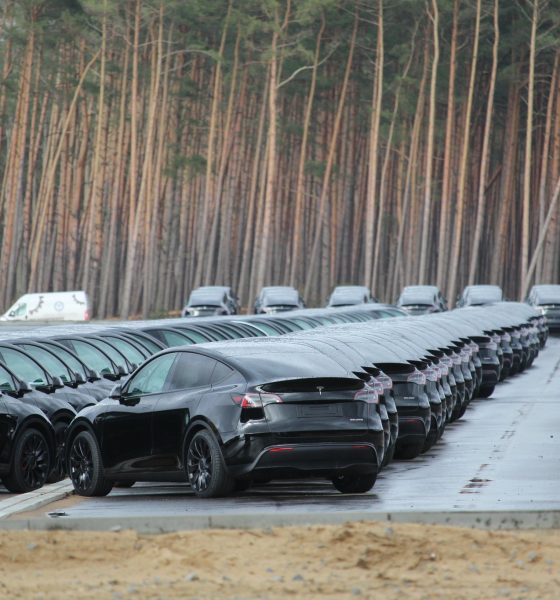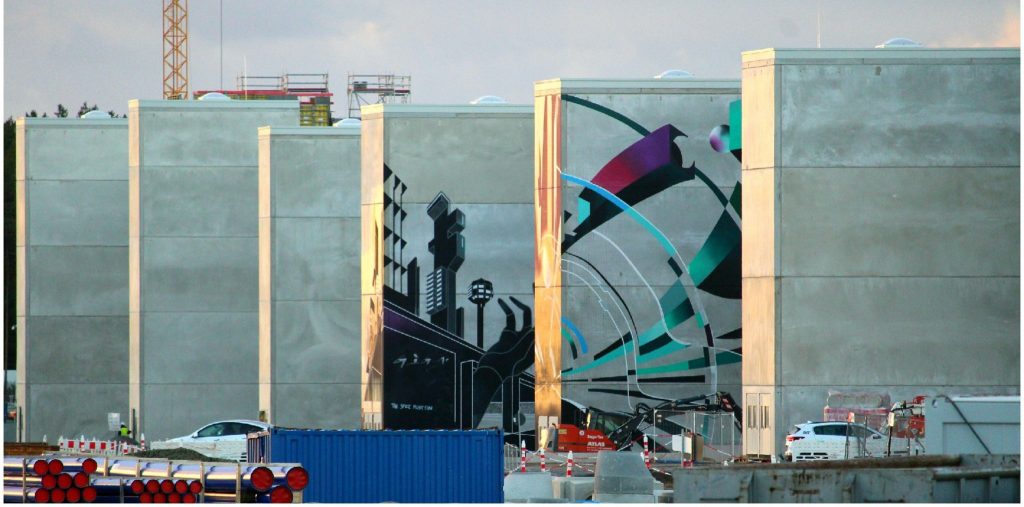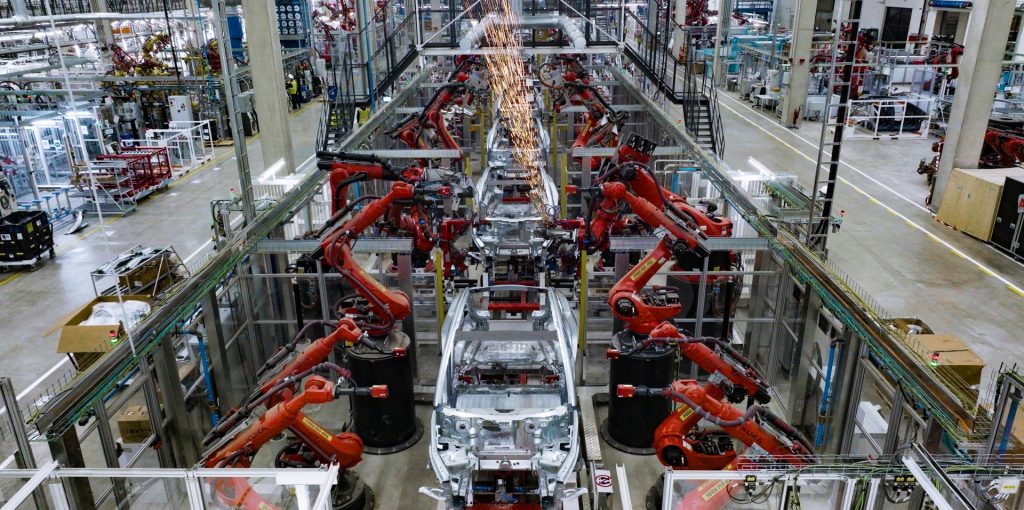

News
Tesla formally wins final environmental approval to open Gigafactory Berlin
The wait is finally over. After a long process that saw delays, controversies, and other drama, Tesla Gigafactory Berlin has won its final environmental approval from Germany. An official document confirming the update was published by the State of Brandenburg, outlining the next steps that the electric vehicle maker needs to do to start vehicle production in its Germany-based electric vehicle factory.
As per the state’s press release, the approval for Giga Berlin covers several activities, such as the production of up to 500,000 vehicles per year. The approval also includes battery cell production activities within the Giga Berlin complex, which should allow Tesla to manufacture its in-house cells from within Germany.
“The project, which was approved with the 536-page decision, includes the plant for the production of up to 500,000 vehicles per year, aluminum smelting plants and an aluminum foundry, plants for surface treatment, heat generation, and storage. The facility also includes battery cell production, an operational wastewater treatment plant, a fire brigade equipment house, a high-bay warehouse, as well as laboratories and workshops,” the press release read.

It should be noted that while it may have taken two years to get to this point, Gigafactory Berlin’s formal approval was still completed in a quick manner, at least relatively speaking. The past two years, after all, required the State Office of the Environment to not only inspect and approve the factory itself, but also the entire industrial area with several large-scale facilities. Environment Minister Alex Vogel expressed his thanks to the state’s employees and other authorities for Giga Berlin’s quick approval process.
“As a high-performing state administration, you have always focused on the technical requirements, the high level of protection of the environment, the protection of the general public and the neighborhood from dangers, even under the pressure of great public interest and unreasonable harassment as well as the legal certainty of the procedure. In times of climate crisis, the availability of water will play an increasingly important role for future developments and settlements. Above all, digitization can help to simplify and accelerate processes without restricting environmental standards and participation rights,” Vogel said.
District Administrator Rolf Lindemann emphasized that Giga Berlin benefits the region. The fact that the project faced much adversity, and was still able to achieve a milestone such as a final environmental approval in a relatively short time, proves that the project’s potential is vast. He also noted that Giga Berlin, as well as those that have been working with Tesla over the past two years to approve the project, shall face whatever challenges lie ahead with vigor.
“The Oder-Spree district described the Tesla Gigafactory as a real stroke of luck for the development of our region. We have therefore mobilized all our strength to help turn this unique opportunity into a visible success. It wasn’t always easy, and we’re anything but done when it comes to the final form of the overall project. But we all have reason to be proud of what we have achieved so far, despite all prophecies of doom.
“That is why we will face the further challenges that lie ahead with confidence and with undiminished vigor. I am referring to the official support of the further expansion stages, the completion of the battery factory and of great importance, especially for local politics: as far as possible, a stress-free integration of the Gigafactory into the traffic infrastructure . However, in order to be able to meet the sustainability aspect and smooth mobility in connection with production, it is of course necessary to start building housing close to the location and to create the associated social infrastructure. We trust in the same support from the state government that we have been able to rely on in the past,” Lindemann said.

While Giga Berlin’s final environment approval has been secured, Tesla still has to ensure that it meets the state’s requirements. These are highlighted by the mammoth size of its approval documents, which comprise over 23,700 pages in 66 files. More than 400 ancillary provisions are included, involving topics such as requirements for groundwater protection as well as water-saving and wastewater-reducing measures, species protection measures, limit values for air pollutants and regulations on their measurement as well as occupational safety requirements. Other specific rules on the plant’s operations, particularly with regards to how it affects the area’s groundwater, were also highlighted in the press release.
“There are 113 air pollution control requirements, which include respective chimney heights for each exhaust air stream. In addition, 22 requirements determine the methods and intervals at which the exhaust air is to be measured. 96 requirements for drinking water protection, waste water disposal and rainwater specify, among other things, limit values for discharge into the waste water pressure line and corresponding cleaning processes. When using building materials, it is important to ensure that no harmful substances get into the groundwater. With groundwater monitoring, both the formation of new groundwater and the quality of the groundwater must be checked regularly. In view of the tense water situation, not least due to climate change, it should be possible to react to changes as early as possible.
“After the inspection by the approval authority, the entire system falls under the provisions of the Hazardous Incidents Ordinance (12th BImSchV) and must therefore take special precautions to prevent incidents and limit the effects of incidents, as well as maintain an appropriate safety distance from adjacent protected objects. Tesla must draw up an incident concept and comply with special information obligations,” the press release read.
The state noted that Tesla may now start or continue with the further construction of Giga Berlin and that objections to the project now have “no suspensive effect.” It should be noted, however, that before Tesla can actually put its Model Y production facility into operation, several ancillary provisions must be met first. These provisions, which include the installation of measuring devices for air pollutants and precautions for fire protection and accidents, will be checked by the responsible authorities. Once Tesla completes this step, Model Y production for customer vehicles could finally commence.
Needless to say, all eyes are now focused on how quickly Tesla can meet the requirements for Giga Berlin’s operational permit.
Don’t hesitate to contact us with news tips. Just send a message to simon@teslarati.com to give us a heads up.

Elon Musk
Starlink passes 9 million active customers just weeks after hitting 8 million
The milestone highlights the accelerating growth of Starlink, which has now been adding over 20,000 new users per day.

SpaceX’s Starlink satellite internet service has continued its rapid global expansion, surpassing 9 million active customers just weeks after crossing the 8 million mark.
The milestone highlights the accelerating growth of Starlink, which has now been adding over 20,000 new users per day.
9 million customers
In a post on X, SpaceX stated that Starlink now serves over 9 million active users across 155 countries, territories, and markets. The company reached 8 million customers in early November, meaning it added roughly 1 million subscribers in under seven weeks, or about 21,275 new users on average per day.
“Starlink is connecting more than 9M active customers with high-speed internet across 155 countries, territories, and many other markets,” Starlink wrote in a post on its official X account. SpaceX President Gwynne Shotwell also celebrated the milestone on X. “A huge thank you to all of our customers and congrats to the Starlink team for such an incredible product,” she wrote.
That growth rate reflects both rising demand for broadband in underserved regions and Starlink’s expanding satellite constellation, which now includes more than 9,000 low-Earth-orbit satellites designed to deliver high-speed, low-latency internet worldwide.
Starlink’s momentum
Starlink’s momentum has been building up. SpaceX reported 4.6 million Starlink customers in December 2024, followed by 7 million by August 2025, and 8 million customers in November. Independent data also suggests Starlink usage is rising sharply, with Cloudflare reporting that global web traffic from Starlink users more than doubled in 2025, as noted in an Insider report.
Starlink’s momentum is increasingly tied to SpaceX’s broader financial outlook. Elon Musk has said the satellite network is “by far” the company’s largest revenue driver, and reports suggest SpaceX may be positioning itself for an initial public offering as soon as next year, with valuations estimated as high as $1.5 trillion. Musk has also suggested in the past that Starlink could have its own IPO in the future.
News
NVIDIA Director of Robotics: Tesla FSD v14 is the first AI to pass the “Physical Turing Test”
After testing FSD v14, Fan stated that his experience with FSD felt magical at first, but it soon started to feel like a routine.

NVIDIA Director of Robotics Jim Fan has praised Tesla’s Full Self-Driving (Supervised) v14 as the first AI to pass what he described as a “Physical Turing Test.”
After testing FSD v14, Fan stated that his experience with FSD felt magical at first, but it soon started to feel like a routine. And just like smartphones today, removing it now would “actively hurt.”
Jim Fan’s hands-on FSD v14 impressions
Fan, a leading researcher in embodied AI who is currently solving Physical AI at NVIDIA and spearheading the company’s Project GR00T initiative, noted that he actually was late to the Tesla game. He was, however, one of the first to try out FSD v14.
“I was very late to own a Tesla but among the earliest to try out FSD v14. It’s perhaps the first time I experience an AI that passes the Physical Turing Test: after a long day at work, you press a button, lay back, and couldn’t tell if a neural net or a human drove you home,” Fan wrote in a post on X.
Fan added: “Despite knowing exactly how robot learning works, I still find it magical watching the steering wheel turn by itself. First it feels surreal, next it becomes routine. Then, like the smartphone, taking it away actively hurts. This is how humanity gets rewired and glued to god-like technologies.”
The Physical Turing Test
The original Turing Test was conceived by Alan Turing in 1950, and it was aimed at determining if a machine could exhibit behavior that is equivalent to or indistinguishable from a human. By focusing on text-based conversations, the original Turing Test set a high bar for natural language processing and machine learning.
This test has been passed by today’s large language models. However, the capability to converse in a humanlike manner is a completely different challenge from performing real-world problem-solving or physical interactions. Thus, Fan introduced the Physical Turing Test, which challenges AI systems to demonstrate intelligence through physical actions.
Based on Fan’s comments, Tesla has demonstrated these intelligent physical actions with FSD v14. Elon Musk agreed with the NVIDIA executive, stating in a post on X that with FSD v14, “you can sense the sentience maturing.” Musk also praised Tesla AI, calling it the best “real-world AI” today.
News
Tesla AI team burns the Christmas midnight oil by releasing FSD v14.2.2.1
The update was released just a day after FSD v14.2.2 started rolling out to customers.

Tesla is burning the midnight oil this Christmas, with the Tesla AI team quietly rolling out Full Self-Driving (Supervised) v14.2.2.1 just a day after FSD v14.2.2 started rolling out to customers.
Tesla owner shares insights on FSD v14.2.2.1
Longtime Tesla owner and FSD tester @BLKMDL3 shared some insights following several drives with FSD v14.2.2.1 in rainy Los Angeles conditions with standing water and faded lane lines. He reported zero steering hesitation or stutter, confident lane changes, and maneuvers executed with precision that evoked the performance of Tesla’s driverless Robotaxis in Austin.
Parking performance impressed, with most spots nailed perfectly, including tight, sharp turns, in single attempts without shaky steering. One minor offset happened only due to another vehicle that was parked over the line, which FSD accommodated by a few extra inches. In rain that typically erases road markings, FSD visualized lanes and turn lines better than humans, positioning itself flawlessly when entering new streets as well.
“Took it up a dark, wet, and twisty canyon road up and down the hill tonight and it went very well as to be expected. Stayed centered in the lane, kept speed well and gives a confidence inspiring steering feel where it handles these curvy roads better than the majority of human drivers,” the Tesla owner wrote in a post on X.
Tesla’s FSD v14.2.2 update
Just a day before FSD v14.2.2.1’s release, Tesla rolled out FSD v14.2.2, which was focused on smoother real-world performance, better obstacle awareness, and precise end-of-trip routing. According to the update’s release notes, FSD v14.2.2 upgrades the vision encoder neural network with higher resolution features, enhancing detection of emergency vehicles, road obstacles, and human gestures.
New Arrival Options also allowed users to select preferred drop-off styles, such as Parking Lot, Street, Driveway, Parking Garage, or Curbside, with the navigation pin automatically adjusting to the ideal spot. Other refinements include pulling over for emergency vehicles, real-time vision-based detours for blocked roads, improved gate and debris handling, and Speed Profiles for customized driving styles.








